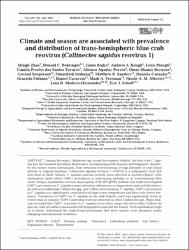| License | Open Access under Creative Commons by Attribution Licence. Use, distribution and reproduction are un - restricted. Authors and original publication must be credited. | es |
| Author | Zhao, Mingli | |
| Author | Behringer, Donald C. | |
| Author | Bojko, Jamie | |
| Author | Kough, Andrew S. | |
| Author | Plough, Louis | |
| Author | Prestes dos Santos Tavares, Camila | |
| Author | Aguilar-Perera, Alfonso | |
| Author | Shamir-Reynoso, Omar | |
| Author | Seepersad, Govind | |
| Author | Maharaj, Omardath | |
| Author | Sanders, Matthew B. | |
| Author | Carnales, Daniela | |
| Author | Fabiano, Graciela | |
| Author | Carnevia, Daniel | |
| Author | Freeman, Mark A. | |
| Author | Atherley, Nicole A. M. | |
| Author | Medero-Hernández, Lexa D. | |
| Author | Schott, Eric J. | |
| Accessioned date | 2022-09-06T12:14:53Z | |
| Available date | 2022-09-06T12:14:53Z | |
| Year | 2020 | |
| Citation | Zhao, M. et al. (2020). Climate and season are associated with prevalence and distribution of trans-hemispheric blue crab reovirus (Callinectes sapidus reovirus 1). Marine Ecology Progress Series, 647, 123-133. Recuperado de: | es |
| URI | https://bvearmb.do/handle/123456789/1481 | |
| Abstract | Among the many Callinectes spp. across the western Atlantic, the blue crab C. sapidus has the broadest latitudinal distribution, encompassing both tropical and temperate climates. Its life history varies latitudinally, from extended overwintering at high latitudes to year-round activity in tropical locations. Callinectes sapidus reovirus 1 (CsRV1) is a pathogenic virus first described in North Atlantic C. sapidus and has recently been detected in southern Brazil. Little information exists about CsRV1 prevalence at intervening latitudes or in overwintering blue crabs. Using a quantitative reverse transcription PCR (RT-qPCR) method, this study investigated CsRV1 prevalence in C. sapidus across latitudinal differences in temperature and crab life history, as well as in additional Callinectes spp. and within overwintering C. sapidus. CsRV1 prevalence in C. sapidus was significantly correlated with high water temperature and blue crab winter dormancy. Prevalence of CsRV1 in C. sapidus on the mid-Atlantic coast was significantly lower in winter than in summer. CsRV1 infections were not detected in other Callinectes spp. These findings revealed that CsRV1 is present in C. sapidus across their range, but not in other Callinectes species, with prevalence associated with temperature and host life history. Such information helps us to better understand the underlying mechanisms that drive marine virus dynamics under changing environmental conditions. | es |
| Language | English | es |
| Published | Marine Ecology Progress Series, 647, 123-133 | es |
| Rights | © The authors 2020. © 2020 Inter-Research. | es |
| Rights URI | https://creativecommons.org/licenses/by/4.0/ | es |
| Subject | Ecología | es |
| Subject | Hábitats y especies | es |
| Subject | Fauna ─ República Dominicana | es |
| Title | Climate and season are associated with prevalence and distribution of trans-hemispheric blue crab reovirus (Callinectes sapidus reovirus 1) | es |
| dc.identifier.doi | 10.3354/meps13405 | |
| Material type | Article | es |
| Type of content | Scientific research | es |
| Access | Open | es |
| Audience | Technicians, professionals and scientists | es |


